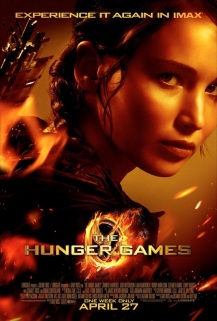bread and circuses: musings on the hunger games
 At the recommendation of a number of people I recently took up reading the Hunger Games trilogy by Suzanne Collins. Not that it was hard to convince me, I found the Hollywood film version of the first instalment enthralling.
At the recommendation of a number of people I recently took up reading the Hunger Games trilogy by Suzanne Collins. Not that it was hard to convince me, I found the Hollywood film version of the first instalment enthralling.
Now that I have finished the series I am suffering from some form of undiagnosed psychological trauma (those who have read the books will understand). Besides that, I greatly enjoyed them (though I must admit, somewhat blasphemously, that I basically never read fiction, so what would I know?).
Many opinions that I read about the books and the film criticised its depiction, and even glorification, of violence. Indeed, the books depict an annual event called the Hunger Games in which children are set against each other in a literal arena of death, forced to gorily fight for their lives until the survivors are crowned victors; terrifying mutant creatures sting and maul and torture and decapitate people; crowds of children and whole villages are firebombed by the Capitol, that is, the ruling regime and its metropolitan capital city.
But to claim that such things glorify violence is, in my view, to miss the point. Certainly the depiction of gruesome levels of killing can serve to glorify violence, but it can equally serve to critique it.
My sense is that the Hunger Games does the latter. The reason for this is the subtler messaging that is encoded throughout the trilogy, messaging that is likely lost on the majority of readers, positioned in the Western world as they are, and unfamiliar with the language of subtlety (we tend to “call it as we see it” because it is unlikely we will be killed if we do).
One of these instances of subtlety that comes to mind is the name given to North America in the books’ dystopian future – Panem.
Some readers will pick up the reference immediately – panem et circenses, “bread and circuses”. This strange phrase derives from the poet Juvenal’s description of Roman public policy in the second century CE:
The people that once bestowed commands, consulships, legions, and all else, now meddles no more and longs eagerly for just two things — bread and circuses! (Juvenal, Satire X.77–81)
Juvenal is saying, in other words, that the people had given up their involvement in politics and public affairs, having been distracted by food (bread) and entertainment (circuses, or games, such as the gladiator battles). Nowadays the phrase bread and circuses is a metaphor for something similar: the attaining of public support by a government or regime, not through good public policy, but rather distraction by way of meeting the immediate and shallow desires of the people.
(In addition to Roman history the Hunger Games also borrows from other historical and mythical episodes, such as the Minotaur, Spartacus, Nazi Germany and reality television, though there is little space to explore those here.)
In the world of the Hunger Games (the title is itself a direct reference to bread [Hunger] and circuses [Games]) the citizens of the wealthy Capitol are distracted from the abject poverty of the twelve surrounding districts of Panem (from which they benefit) by way of luxury and, of course, the annual Hunger Games. Each of the outlying districts provide a crucial service for the capital, such as food, coal, electricity or clothing. However the presence of never-ending food and entertainment mean the residents of the Capitol ask no questions about this exploitation and concern themselves with petty matters that pale in comparison to the impoverishment of the citizens of Panem’s outer districts.
The violence of the Hunger Games can be viewed from a number of different perspectives, but certainly in terms of the Games themselves the children are but victims of the inhumane demands of the Capitol. The Hunger Games exist as punishment for the districts for a past attempt at rebellion against the Capitol, and seventy-four years later the regime insists on forcing the districts to each offer two teenagers, a male and female, for their bloody entertainment. The violence itself is part of the panem et circenses. This is not to defend the often violent actions of the characters, victim or not, and I’m sure much discussion can and should be had about such issues. But what these actions do reflect is the tendency of oppressive regimes to drive people into a corner, only to be scandalised when the same people fight back – this should not be lost on us in our world.
The parallels in the Hunger Games with modern life in the Western world are striking, though obviously overstated in a dystopian fashion. Among them, and relevant to Australians at this point in time, is our deferral of any real political responsibility as we concern ourselves with the consequences of our own lifestyle choices (or should that be entitlements?) – our culture looks, in many ways, eerily like that of the Capitol of Panem.
Not being a parent I cannot comment authoritatively or even empathetically as to whether children should see this movie or read these books. That said I would point out that the Hunger Games has the potential to resensitise us to violence. In the Hunger Games trilogy you will not find deaths suffered by hordes of people we do not care about (as with, say, the Transformers movies); on the contrary, the deaths mainly occur to characters we have become in some way attached to. This brings the reality that all who are victims of violence are also loved by someone to the fore as we feel the devastation of beloved characters meeting their grisly demise under the hand of a regime that looks, in many ways, not so dissimilar from our own societies. I’m sure, however, that we are mostly blind to it.
Well that’ll do for now. Looks like you can go back to watching your ultimate fighting, manly Christian fellow.
MCA
Posted on June 6, 2012, in Conflict and Nonviolence, Culture & Art and tagged Bread and Circuses, Bread and Games, Catching Fire, Hunger Games, Juvenal, Mockingjay, Panem et Circenses, Violence. Bookmark the permalink. 4 Comments.



I surprisingly enjoyed these books, if only for the story line.. because lets be honest, the writing style is boring and uninspiring. But, I don’t take offense at the sweeping images of brutality or violence, but the self harm and suicidal tendencies. Both Katniss and Peeta hurt their wrists to ‘keep a grasp on reality’, and the whole way through one or both of them talks about suicide as if its a viable, logical option.
I think I see what Collins is going for here – in the face of distress, death etc, people get desperate. In a war torn area I have no doubt that these types of coping mechanisms are very much at the front of peoples minds. But, she offers no solution, no help, and no means out. It’s only by chance that Katniss doesn’t have to kill herself. Collins makes no attempt at writing of the anguish behind self harm.
When this is targeted at youth – well, it alarms me.
I took my sons (10 & 13) to see the movie and we all enjoyed it. It opened the door for conversation about honour and poverty / greed and plenty. My older son has since started to read the series.
I don’t think it ‘promotes’ violence, rather it critiques it. I have only read the movie and so can only comment on it – but the ending of the movie showed that even the powerless have power over life / death and can make their own choices. What would have been the result if the contestants took their lives and their was no victor left standing – what would have the result have been for the nation?
Yes they were martyr hero’s at the end of the movie. I was more referring to the third book and some stuff that goes on there..
Indeed, things only get more messed up in the second and third books.
My sense is that, like most people, Collins probably has an underdeveloped notion of nonviolent resistance and this shows in her books, which are in themselves a kind of critique of violence. I’m not sure that she can imagine a viable alternative to violence though, which is why the Peeta character, for all his objections to violence, nonetheless practices it on himself and others.